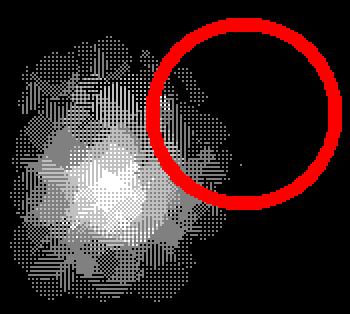Patrick is working on a master's thesis on animated GIF art and sent these questions.
When and why did you start making animated GIFs?
What is/was your main motivation behind choosing GIF for your works?
The art I was showing in New York City in the late 1990s was made with a simple paint program (Microsoft Paintbrush, later called Paint). I was printing out elements such as spheres, concentric circles, and stick-and-ball molecule diagrams, and making collages with the prints. In the early 2000s I was showing this work on my blog, and at the same time started making patterns using basic HTML and found animated GIFs. My work with found GIFs was done in 2003, and by November of that year I started making and posting my own animated GIFs. See for example,
http://www.digitalmediatree.com/tommoody/?24117
http://www.digitalmediatree.com/tommoody/?24283
I started blogging in 2001 and realized by '03 that GIFs were a way to provide visually dynamic, "web friendly" ideas that fit in with my lo-fi graphic aesthetic. By 2004 I was making GIFs more of a central part of my online work, and in the next couple of years I was being asked to submit GIFs to gallery exhibits.
I'm interested in low fidelity formats for philosophical as well as aesthetic reasons. Computers are sold on the idea of seamless perfection and efficiency but they are in fact riddled with approximations, guesswork, errors, and attempts at thought control. I don't care about making a perfect sphere, I want viewers to see how the sphere is made, with all its flaws and clumsiness, as well as insight into the thinking process that led to an unknown programmer's idea of "perfection."
Why have you chosen GIF over other formats (like video, flash, …)?
It wasn't a choice for me. I had no interest in video at that time, and I disliked the smooth "vector" style of Flash. I had no desire to learn Flash and resented that I had to install a plug-in to play Flash content on other people's websites. GIFs looked appealing to me, every browser could read them without needing a plugin, and there is a very small learning curve to make them. Essentially I was just importing my MSPaint drawings as frames and animating them at 10 frames a second.
See, e.g.
http://www.digitalmediatree.com/tommoody/?24958

Do you feel that the technical limitations of the GIF format have/had a notable influence on your artworks?
In this context, do you think that limitation fuels creativity?
As mentioned above, technical limitations were already a feature of my work. I prefer a lower frame count and reduced color to the slick, polished look of photo-based video.
What are your thoughts on the current popularity of animated GIFs?
When I did my show in Brooklyn, NY called "Room Sized Animated GIFs," in 2006, very few people in the gallery world knew what a GIF was. As late as 2011, we were talking on the Art F City blog about the lack of interest of big web/computer companies in the GIF format.
Facebook didn't allow them, Google had no hard-wired way to search for animated GIFs, Windows 7's picture viewer no longer "played" animated GIFs, unlike XP, which did.
That year, Art F City's Paddy Johnson organized a GIF show in a college gallery, and more and more articles started appearing about GIFs. By 2012 GIFs were a "thing" -- widespread and popular. Google added animation to its search and started promoting Google+ as a "GIF friendly" site. It's been intriguing, as an early adopter (though by no means the earliest), to watch this cultural phenomenon take off.
Do you think that selling Animated GIFs (in any possible form) is an appropriate way of increasing its value as an art form?
Anything that helps artists to do their work and give recognition to their efforts is good. I have sold limited edition DVDs made with my GIFs. This doesn't hinder the life that those GIFs may have as expressions circulating around the web.
